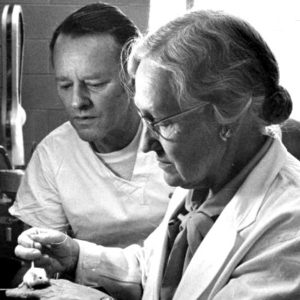calsfoundation@cals.org
Margaret Pittman (1901–1995)
Margaret Pittman was known worldwide for her pioneering research into the microbiology and immunology of infectious diseases. Her work in developing a vaccine for whooping cough remains the scientific basis (with later improvements) for protecting the children of Arkansas and the world from this potentially deadly disease.
Margaret Pittman was born near Prairie Grove (Washington County) on January 20, 1901, to James Pittman, a country doctor, and Virginia Alice McCormick. In 1909, the family moved to the village of Cincinnati (Washington County), where Margaret and her sister sometimes helped with administering anesthesia and vaccinating patients in their father’s practice. After his early death, Virginia Pittman took her children—Margaret, Mary Helen, and James—to Conway (Faulkner County), where she did dressmaking and canned fruits and vegetables at home to help support their studies at Hendrix College.
Margaret Pittman graduated magna cum laude from Hendrix in 1923 with a BA in mathematics and biology. Afterwards, she taught at Galloway College in Searcy (White County), then went to study at the University of Chicago, where she earned a master’s degree in bacteriology in 1926. She was offered a fellowship to pursue a Ph.D., “an opportunity undreamed of,” she said. She left Chicago in 1928 to work as a research scientist at the Rockefeller Institute of Medical Research in New York. She obtained her Ph.D. degree from the University of Chicago in 1929.
At the time she graduated, bacteriology was a relatively new science. Rapid progress had been made in the discovery of the causes of infectious diseases, but even so, in the early twentieth century, many diseases—typhoid fever, diphtheria, pneumonia, whooping cough, scarlet fever, and others—could not be prevented. The year 1918 saw the worst outbreak of infectious disease in modern times, the “Spanish flu” pandemic in which some twenty to forty million people died worldwide, half a million of them in the United States. Pittman began her career in its aftermath, when society was dedicating great resources to the control of disease by public health measures.
At the Rockefeller Institute she studied the bacteria Haemophilus influenzae, which can cause a range of infections in humans, including bronchitis and sinusitis. She observed that some strains of these bacteria have a capsule (a special covering) that allows them to enter the blood stream readily and overcome natural defenses. In all, she identified six encapsulated strains, one of which causes a form of meningitis in children. These discoveries, along with co-authorship of several publications on pneumococcus pneumonia and other research papers, won her an international reputation before she was thirty years old.
In 1936, she joined the National Institute (later Institutes) of Health, where, for most of her career, she was involved in the production, testing, and standardization of vaccines to prevent typhoid, cholera, pertussis (whooping cough), and other diseases. She promoted the concept that the effectiveness of a vaccine is related to its potency, as determined by laboratory tests, and she became well known for developing methods for testing the potency of vaccines.
During World War II, Pittman worked on developing standards for blood plasma. Great amounts of plasma were used to treat the wounded, but blood transfusions sometimes caused severe fever and chills. She and colleague Thomas Probey developed means for assuring the safety of blood plasma.
In 1943, she began work on a vaccine for pertussis. Together with colleagues, she developed a technique for testing the safety and efficacy of the vaccine. Her work became the basis for an international potency requirement. Within five years of the establishment of the requirement, there was a dramatic drop in the death rate. She said that “despite the problems that have occurred with the pertussis vaccine… I consider this work one of my best accomplishments.”
Pittman was chief of the Laboratory of Bacterial Products, Division of Biologics Standards, from 1957 until 1971, the first woman to head a major laboratory at the National Institutes of Health (NIH). She was known as a blunt, straight-to-the-point sort of person, systematic and energetic. Her colleague, Dr. Harry Meyer, said that she “was always seeking and embracing the new, and could recognize new opportunities in new technologies.”
She was involved in research on cholera in Pakistan with the Southeast Asia Treaty Organization from 1960 to 1970, she served as NIH project director of cholera research for from 1965 to 1970, and she was a consultant to the World Health Organization (WHO) several times between 1959 and 1983. After her retirement in 1971, she continued by invitation as an unpaid guest worker at NIH. From time to time, she worked as a consultant for WHO and as a consultant or guest scientist in several countries, including Spain, Scotland, Egypt, and Iran.
In 1976, she was wrestling with the problem of why pertussis vaccine had a number of toxic side effects. As she paced the floor, an insight “suddenly…came to [her] that pertussis had a true exotoxin [a protein toxin excreted by bacteria], like diphtheria or cholera toxin, that caused the harmful effects.” Her concept of pertussis as a toxin-mediated disease contributed to the development of a safer vaccine. It was “satisfying to have changed the direction of work on pertussis vaccine,” she later said.
Among her honors was the Federal Women’s Award in 1970, which stated that “her ability to identify problems, stimulate research and evaluate results have made her an unusually effective leader.” In 1986, she was elected to Honorary Fellowship in the American Academy of Pediatrics for her “efforts in improving the health and welfare of children.” The Margaret Pittman Lectureship at the National Institutes of Health was established in 1994 to honor her for her accomplishments there. As one in a series of lectures sponsored by NIH, it facilitates the interchange of information and recognizes outstanding scientific accomplishment.
Pittman loved to garden, enjoyed traveling, and was active in the Mount Vernon United Methodist Church of Washington DC. She died in Cheverly, Maryland, on August 19, 1995, and is buried in the Prairie Grove Cemetery.
For additional information:
Dowling, Harry F. Fighting Infection: Conquests of the Twentieth Century. Cambridge, MA: Harvard University Press, 1977.
Harden, Victoria A. “Reflections of Fifty Years at NIH: An Interview with Margaret Pittman.” NIHAA Update, Spring 1989, p. 1, 8–15.
McBride, Gail. “Margaret Pittman: Down to a Forty-Hour Work Week.” Medicine on the Midway: Bulletin of the Medical Alumni Association, University of Chicago, Spring 1987.
Pittman, Margaret. “A Life with Biological Products.” Annual Review of Microbiology 44 (1990): 1–25.
Obituary of Margaret Pittman. Northwest Arkansas Times. September 1, 1995, p. 2A.
Obituary of Margaret Pittman. Washington Post. September 14, 1995, p. 6B.
O’Hern, Elizabeth Moot. Profiles of Pioneer Women Scientists. New York: Acropolis Books, 1986.
Nancy Ann Williams
Fayetteville, Arkansas
This entry, originally published in Arkansas Biography: A Collection of Notable Lives, appears in the CALS Encyclopedia of Arkansas in an altered form. Arkansas Biography is available from the University of Arkansas Press.
 Health and Medicine
Health and Medicine World War II through the Faubus Era, 1941 through 1967
World War II through the Faubus Era, 1941 through 1967 Margaret Pittman
Margaret Pittman 



Considering the recent memo delivered to NASA to scrub references to women in science away (early 2025), it’s good to see women’s history being celebrated elsewhere. What a wonderful contribution she made to humanity.